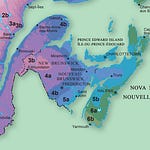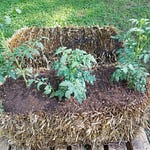Gardeners are at their most vulnerable in their quest for soil amendment. Garden center salespeople spot these individuals like wolves picking out stragglers from a herd, and they move in quickly to “help”, offering a range of potions, powders and pastes. Some of these may help in the short term. Most of them are a waste of money.
We all wonder about our soil quality from time to time, but we don’t always ask the right questions. (source: https://www.peakpx.com/en/hd-wallpaper-desktop-fxtwe)
The standard advice that any horticulturist will offer whenever someone asks about their soil is to get a soil test, and to add the things that the soil test says are lacking in the soil. This isn’t bad advice – but it still may not help, because a soil test can only tell you so much. In general, it will tell you how many parts per million (ppm) you have in the soil for phosphorus (P), and potassium (K), and magnesium (Mg), and the pH of the soil – and then it will tell you what needs to be added to the soil to bring the levels up to optimal. This sounds great in principle, but it only gets you so far, and the suggested solutions are temporary at best.
Here’s an example of soil test results. As you can see, the results say nothing about soil structure or available nitrogen. (source: https://extension.psu.edu/interpreting-your-soil-test-reports)
Soil tests do not tell the whole story
A closer examination of the results of a soil test will reveal that many pieces of the puzzle are still missing, despite the useful information that they provide. While you now know your soil pH, P, K and Mg – you still have no idea if it has enough nitrogen for the plants you are trying to grow – or if it’s getting enough hours of good sun, or if it’s too wet or too dry. You also don’t know anything about it’s structure – and that’s important!
What is good soil structure?
Soil is a combination of sand, silt, clay, organic matter, water and air. Its is generally held that good agricultural soil has 50% pore space, 45% mineral matter and 5% organic matter.
“Pore space” is the air pockets between the mineral and organic matter, and it is always comprised of some combination of water and air. After it rains, the soil has more water than air. If days go by with no rain, the ratio flips and there is more air than water in the pore space.
“Mineral matter” is a combination of sand, silt and clay, which are are all particles of rocks at progressively finer stages of being broken down over time. Sand has the texture of sand, silt has the texture of super-duper-fine sand, and clay has the texture of talcum powder. Good soil, in terms of its mineral matter, has about 40% sand, 40% silt, 20% clay. This ratio, in combination with the organic matter, allows for the optimal pore space.
Sand is enormous in size relative to silt, which is enormous relative to clay, and that’s why it’s so important all three in the right proportion to ensure good pore space. (source: http://techalive.mtu.edu/meec/module06/SoilClassification.htm)
“Organic matter” is stuff that is either alive, or is dead and is in some stage of decomposition. Good soil is about 5% organic matter. It seems odd that this component of the soil composition is so small when one considers how important organic matter is for soil health, but this is all that’s needed. Organic matter, aside from its capacity to hang on to water, provides the “food” that is required by all the soil organisms (fungi, bacteria, worms, insects, etc.).
Why good soil structure matters
Let’s step back a minute and think about soil from the point of view of the things that live in it. Soil organisms need air, water and food. The pore space provides the air and water. If the soil is all sand, then there will be too much pore space and it cannot hang on to water; conversely, if the soil is all clay, it is too dense, which has the opposite effect. It’s also the case that with the right amount of pore space the soil organisms can more around freely to do what they need to do.
Your plants also live in the soil, and they need a steady supply of water, air and nutrients from the soil. Good soil structure, by virtue of its optimal pore space, provides the necessary air and water, but it also provides the nutrients in two important ways:
(1) the presence of the organic matter, and the optimal conditions for the soil organisms, allow for the constant breaking down of organic matter such that it is reduced to forms that can be absorbed by the plant roots; and,
(2)the nature of good soil’s ability to “hang on” to nutrients allows nutrients to be stored in the soil, so they are always available for plants to take up when they need them. This is possible because clay and organic matter have electromagnetic properties that allow nutrients to “stick” to them, and not get washed away by rains.
How do I determine my soil structure?
The “jar test” is the simplest way to determine what proportion of your soil is sand, silt and clay. Dig down about 8” into the soil and fill a 1 quart jar half full with the soil. Fill the jar 3/4 full with water, add a teaspoonful of dish soap, cover the jar and then shake vigorously for a couple minutes. Now wait for it to settle out for a couple days. Once the settling process has completed there will be three distinct strata on the soil, with sand on the bottom, then silt in the middle, and clay on top. Measure the height of each soil layer, then divide the height of each soil layer by the total height of the soil column in the jar to get your soil proportions. You may want to do this in multiple locations in your garden because soil composition can vary over large areas.
The settling process takes time. The sand and silt settle out quickly, but he clay can take a couple days to settle out - and you’ll know it’s done when the water becomes clear. (source: https://www.caryinstitute.org/sites/default/files/public/downloads/lesson-plans/estimating_soil_texture.pdf
Final Thoughts
If you find yourself thinking that your soil needs more N, P, K, Mg, etc. – sure, get a soil test – but maybe first, figure out what kind of soil you have in terms of its structure. At the same time, please bear in mind that ratios like 40% sand, 40% silt and 20% clay are guidelines, not commandments burned into tablets with lightening bolts. As long as your measurements are close, everything should be fine. It’s also the case that by keeping your soil mulched, a multitude of problems will be compensated for by virtue of the ability of mulch to prevent evaporation, and the favourable environment it creates for soil organisms. Amending soil that lacks good structure is like putting money in a bank that’s run by a problem gambler: it’s not a good long term investment.
FREE SHIPPING FROM VESEYS SEEDS
Use my NEW coupon code “GAVS25” to get free shipping from Veseys Seeds on seed catalogue orders. Free shipping is not applicable on surcharges on larger items. Promo code is valid until November 30, 2025.


















Share this post